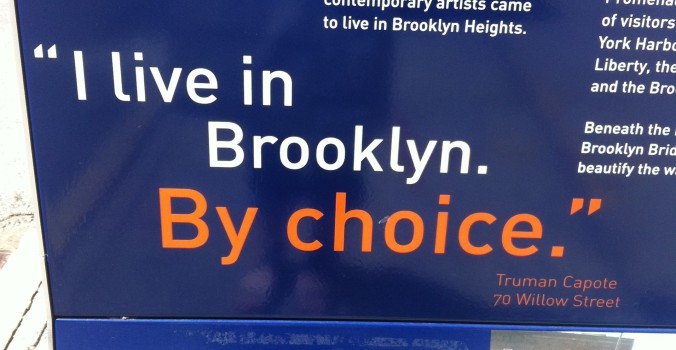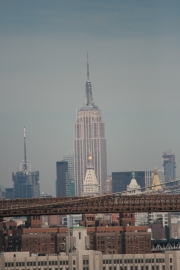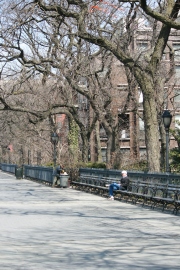One of the more interesting (and accidental) adventures R and I had while in the Big Apple was our day trip to Brooklyn. It started off innocently enough. We took the subway over to Brooklyn Heights and popped into Clark’s Restaurant for breakfast (it was dinerly divine – as was the Deluxe Lunchette on Broadway while we are on the subject…) Brooklyn Heights reminded me a lot of Noe Valley. I realize I have already openly admitted that this kind of comparative evaluating is of little value, but I can’t help myself. Anyhow, the area was cute and neighborhoody and it had nice shops. And it was freezing cold. But we persevered, and by that I mean we shopped. But only to get out of the cold.
We wandered around cute little streets and saw no famous people. Where was Anne Hathaway? Michelle Williams? No bother. We saw some other famous faces – if from afar.
And it was pretty, I could see why people would like this view, though we both contemplated how traumatic it would have been back in September of 2001. And the skyline is so very notably different from this vantage point. In an effort to get a “sense” of Brooklyn we decided to walk it out. Plus we were enjoying the idea of walking for miles, especially when not hitting up Equinox on the daily. So we started to walk, the general route being along the waterfront near the Brooklyn Bridge Park, then through Dumbo (is this is really a place? Yes this is really a place and the Heartwalk is there now) and then we were heading to the apparent place du jour – Williamsburg. Supposedly this place is really the shit in terms of shopping, food and general coolness, so checking it out seemed only right. The thing is, if you check out a map, while the walk itself was not too long, per se, it was a curious visual situation. We were basically following the Brooklyn-Queens Expressway, a route certainly not intended to be entirely pedestrian. We saw some pretty bridges, and Dumbo was interesting, and we basically circumscribed the old Brooklyn Navy Yard, not part industrial park and part ruins – though, the crumbling edifices have potential… Expensive potential, but solid aesthetic foundations.
We basically took Flushing Avenue around until we hit Lee Avenue to take us north towards the more “Williamsburg-y” part of Williamsburg.
So, yeah.
Now, I have to preface this next part of the narrative by saying that I am very close with many Jewish people, some (especially in the Bay Area who I consider kind of conservative. I am in no way an anti-Semite, although I realize making this declaration will lead people to immediately assume that I am. I also have to admit that I am and have always been fascinated by closed off, exclusive communities, whether religious like the FLDS, the Amish, the Mennonites, or cultural ike the Romani, or even more extremist groups like the Branch Davidians, the Manson Family, the KKK, and others of similarly unfamiliar ilks. I am really curious about what kinds of belief structures can be in place that allow people to remove themselves so dramatically from what seems like a pervasive modern (and Western) cultural patina. Or I am shocked that there are groups who don’t want me to join. [I subscribe to the Zora Neale Hurston attitude more than the Groucho Marx persepctive.]
Considering all of the aforementioned facts, there are few words to describe how I made my way down Lee Avenue as we were trekking towards what I thought was going to be something altogether different. Perhaps agog. Or agape. Both. I simply could not wrap my head around what I was seeing, and I consider my self a person who has seen a lot of shit. I have never seen this kind of thing. We were smack in the middle of one of the most significant Satmar communities in America.
We were not dressed inappropriately or anything, but we were clearly foreign, and there was that weirdness, like walking in on a party that you were not exactly invited to and you are dressed way different from everyone else. You know, like this.
Anyhow, here we were.
The most obvious element was the clothing, obviously, and the hair, which I unfortunately called side locks, which lead to a short-lived moment of awkward synthesis a la Merchant of Venice. Barely worthy of Shakespearean comedy, but you know. [They are actually called payot – peyot? and are apparently a result of a line in the Torah which says “Do not cut off the hair on the sides of your head…” Vayikra 19:27.] And everyone was in a tremendous hurry, especially the men. Eye contact did not happen, cell phones were omnipresent.
But upon closer examination, other things started to stand out. It was not coincidence that all the women had the same hairstyle – they were wearing wigs. And they did not look healthy. At all. I am aware that not everyone tans, and that to be pale, especially among Central Euros as these people are descended from, could be totally normal. But these folks did not look normal. By and large they had hug dark circles under their eyes and a pallor that suggested perhaps anemia or maybe severe malnutrition.
For the duration of this part of our walk all of the signs were in Hebrew, or Yiddish and we heard very little spoken English, though conversations would weave in and out of the two languages. I was absolutely fascinated to see this community right here, juxtaposed with the rest of Brooklyn, or NYC. It was like walking through a David Lynch film. Totally surreal.
Of course, this made the rest of Williamsburg completely uninteresting to me. As soon as we got to a place to sit down (after checking out a small selection of shops – kind of disappointing really, though I should have bought that one pari of shoes at Pema that I passed on… I never do that) I promptly got on my iPhone to read about the people who we had just been witness to. We chose Spike Hill (not bad, nice bartender, and really, beer and french fries? Done and done.) I am pretty sure I just kept saying I could not believe how strange the whole experience had been walking through the Hasidic community.
Unable to shake my curiosity about this whole experience, I just kept trying to figure out what it was that seemed so odd. Clearly the nature of fundamentalists is unfamiliar and really rather incomprehensible to me. I do not understand such a strong adherence – compulsion – to interpreting life though religious texts for one, and then of course there is the standard misogynist structures that seem to accompany most of these groups which definitely does not sit well with me. [You are NOT the boss of me, has been a life long mantra struggle for me.] The strangeness and the weird vibe (not to mention Ruth caught a man, side locks and all, perving on us from his car) were just too much for me to let go.
So I did what I do… I started to read about these folks.
I knew about the “unique” banking habits and beliefs – that they basically do not use regular banks and tend to travel with large amounts of cash and diamonds, which is hard to find fault with really. But that was sort of it, and I have to admit a lot of my info re: these habits had been gleaned from Guy Ritchie’s work, which seems a bit limited in terms of fact checking.
The population in this part of Brooklyn are Satmar Hasids. Their roots are primarily Hungarian and Romanian, and they are descendants of Holocaust survivors. There is somewhere around 130,000 people who identify as Satmar, and though the number is probably inaccurate because the community is so closed off, it is widely acknowledged that the population is rapidly increasing because of the very high birth rate (Satmar girls are intended for marriage in their teens and meant to start having children right away – aiming for six to eight according to many sources.)
As with most fundamental religious movements, there is much emphasis on total commitment as demonstrated through segregation, dress, and lifestyle. Interestingly, I had always thought the most orthodox of the Jewish community to be hyper-Zionist as well, but the Satmar community is rabidly anti-zionist. Still, they hold deeply to the religious symbolism in their dress, down to their hair styling, and of course… the ritual of Jewish circumcision.
And this is where I fell off the rails. I can get behind a belief that promotes and even requires modesty. spend one day at a public high school in the spring and you will see what I mean. In the same way that I understand that leanings toward the hijab (less, so the full burqa, but I do get the underlying belief) it makes sense that conservative practitioners of any faith would endorse modesty – I mean, it was not that long ago that Western men and women were not meant to be seen with their heads uncovered in public either. Further, I understand that clothing can take on a lot of specific and important meaning for the wearer. Just because I happen to subscribe to a more personal faith, based on really nice shoes does not prohibit me from understanding that there is significance behind a rope worn at the waist, specific colors (especially black), and while I think this is a bit more than I would choose to deal with, it is, as they say, a free country, right? [Freedom is slightly limited in Williamsburg where the Hasidic community has a “Modesty Patrol”…]
Let me return to the specific element of this story that threw me sideways. It is a free country. This is a country based on the principle that the freedom of religion shall not be abridged or restricted. Soooo… communities like the Mormons fundamentalists and the Branch Davidians, and the Satmar Hasids are given the freedom to exist. But what about when they break basic laws on the basis of religious practice? Then what? What is happening in New York (and it appears in several Hasidic communities) is that there is an emerging public health crisis surrounding their practice of circumcision and the spread of herpes simplex 1. This is not some standard kind of bris where a ceremonial cutting occurs. It is the practice of metzitzah b’peh: a religious practice that dates back to more than 5,000 where a direct-oral-contact technique to draw blood from the penis of an 8-day old infant at his bris milah perform the oral suction on an open wound.
As if I would make this up.
So in a nutshell (ummm… no pun intended?) what is happening is the practice can infect newborns with herpes simplex virus type 1, according to medical authorities. While not serious for adults, the virus can be fatal for infants, or cause permanent cognitive or physical harm.
And now it gets all cloudy. Who is withholding the information? Should this be something that practitioners of the faith should have the choice to do even if there is serious risk to the child because no one is talking about which rabbi’s are spreading the disease because, well, no one is talking. One of the first people to speak out about this was a well-known rabbi who claims the problem is far worse than people think, and he said his daughter explained that the hospitals do not report these cases because Hasidic clients would not return if they were made public. The current result is a growing risk (non-disclosure and rising birth rates only exacerbate problem) and the age-old conundrum of what to do with the grey area of religious freedom.
Frankly, the whole thing made me so uncomfortable I could barely keep reading the above news story that (re)broke the day after I left NYC. But I couldn’t stop either. And in spite of my best efforts to understand the unique interpretations of religion and whatever… I cannot get on board with male-to-infant oral-genital contact in any way. My comprehension stops about a million miles before that. If I am going to fight for religious freedom above the law it is going to be along very different lines.













